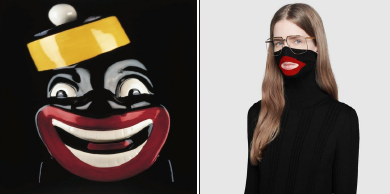Secret symbolism in the fashion industry crosses cultural boundaries

March 8, 2019
A series of scandals brought the issue of “blackface”, when nonblack people darken their skin using makeup or other products to imitate a black person — exploding back into the cultural conversation.
Most high-profile blackface incidents have largely been confined to college campuses, ill-advised Halloween costumes, and bizarre television sketches.
The most recent blackface controversy began when both Prada and Gucci were accused of being racist when some of their products resembled blackface. Prada released a monkey key chain that shows a monkey with red all over the bottom half of the monkeys face.While
Gucci came out with a hoodie the goes all the way up to your nose but there is an opening for the mouth which is surrounded by a red “lipstick”.This turtleneck resembles the cartoon character named Mr.bones who was created in 1995. A political example of blackface is of Democratic Virginia Gov. Ralph Northam after photos from his 1984 medical school yearbook were leaked, showing a person in blackface and one in Ku Klux Klan robes.
Many celebrities such as Floyd Mayweather and T.I have publicly expressed their complete disapproval of these luxury fashion brands following these blackface controversies.
Reported hate crimes in America increased 17 percent last year, according to the FBI, the third straight year that such crimes increased. Of the more than 7,000 incidents reported last year, 2,013 targeted African-Americans. Incidents of racial bullying in K-12 schools are also growing. Last April, the Utah chapter of the NAACP called for schools to address a growing number of incidents in which white students used racial slurs against black students. A student in Los Angeles and another in Missouri turned up at school in KKK costumes for school projects last year.
A majority of Americans – 56 percent – and 88 percent of Democrats say the practice is unacceptable for a white person, but 29 percent of Republicans and 30 percent of Trump voters disagree, according to a survey from The Economist/YouGov.
“A examination of the of privilege and race in American society is unlikely to follow” says George Yancy, a professor of philosophy at Emory University and author of “Backlash: What Happens When We Talk Honestly about Racism in America.”
“The representation of blackness as dangerous, inferior, as buffoonery and aesthetically ugly continues to exist in every nook and cranny of white America,” he says. “Until white Americans develop the stomach, the capacity to begin to admit the ways in which racism continues to exist in them, both consciously and unconsciously, this moment will be just another racist incident we talk about for about a week and then move on.”
Fundamentally people don’t understand the rootedness of anti-blackness in American culture,” says Jeannette Eileen Jones, associate professor at the University of Nebraska-Lincoln.
It’s been nearly 200 years since white performers first started painting their faces black to mock enslaved Africans in shows across the United States. It was racist and offensive then, and it’s still racist and offensive today.

